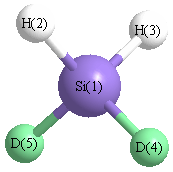All results from a given calculation for SiH2D2 (silane-d2)
using model chemistry: QCISD(TQ)/cc-pVQZ
19 10 17 12 22
States and conformations
| State |
Conformation |
minimum conformation |
conformer description |
state description |
| 1 |
1 |
yes |
C2V |
1A1 |
Energy calculated at QCISD(TQ)/cc-pVQZ
| | hartrees |
|---|
| Energy at 0K | -291.451235 |
| Energy at 298.15K | |
| HF Energy | -291.266041 |
| Nuclear repulsion energy | 21.338857 |
The energy at 298.15K was derived from the energy at 0K
and an integrated heat capacity that used the calculated vibrational frequencies.
Vibrational Frequencies calculated at QCISD(TQ)/cc-pVQZ
Geometric Data calculated at QCISD(TQ)/cc-pVQZ
Point Group is C2v
Cartesians (Å)
| Atom |
x (Å) |
y (Å) |
z (Å) |
|---|
| Si1 |
0.000 |
0.000 |
-0.000 |
| H2 |
0.000 |
1.208 |
0.854 |
| H3 |
0.000 |
-1.208 |
0.854 |
| H4 |
-1.208 |
0.000 |
-0.854 |
| H5 |
1.208 |
0.000 |
-0.854 |
Atom - Atom Distances (Å)
| |
Si1 |
H2 |
H3 |
H4 |
H5 |
| Si1 | | 1.4800 | 1.4800 | 1.4799 | 1.4799 |
H2 | 1.4800 | | 2.4168 | 2.4167 | 2.4167 | H3 | 1.4800 | 2.4168 | | 2.4167 | 2.4167 | H4 | 1.4799 | 2.4167 | 2.4167 | | 2.4166 | H5 | 1.4799 | 2.4167 | 2.4167 | 2.4166 | |
 More geometry information
More geometry information
Calculated Bond Angles
| atom1 |
atom2 |
atom3 |
angle |
|
atom1 |
atom2 |
atom3 |
angle |
| H2 |
Si1 |
H3 |
109.471 |
|
H2 |
Si1 |
D4 |
109.471 |
| H2 |
Si1 |
D5 |
109.471 |
|
H3 |
Si1 |
D4 |
109.471 |
| H3 |
Si1 |
D5 |
109.471 |
|
D4 |
Si1 |
D5 |
109.471 |
Electronic energy levels
Charges, Dipole, Quadrupole and Polarizability
